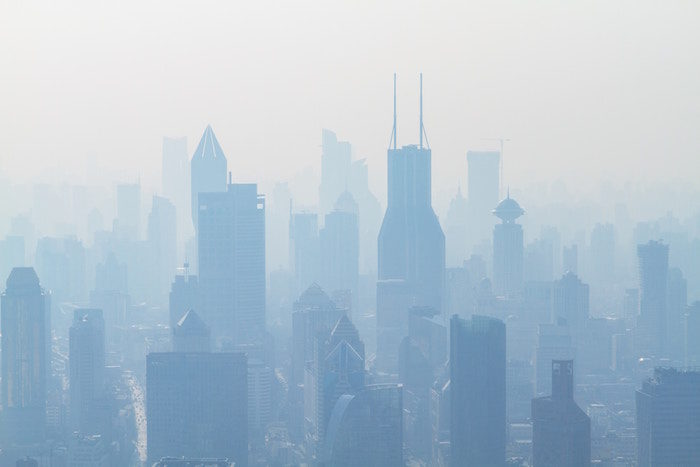A version of this article was first published on the Ethical Unicorn.

Air pollution is something that affects 91% of the world population. There are a few main pollutants with the strongest evidence of health effects, which are ozone (O3), nitrogen dioxide (NO2), sulphur dioxide (SO2), and particulate matter (PM), however I’m going to pay particular attention to PM, also known as aerosols.
What are aerosols?
An aerosol is a tiny particle (solid or liquid) in the atmosphere. Some aerosols are so small that they are only made of a few molecules and are invisible, some are visible but still very small. The smaller and lighter a particle is, the longer is stays in the air. Larger particles settle to the ground due to gravity after a few hours, whereas the smallest particles can stay in the atmosphere for weeks.
Aerosols can derive from natural processes, like salt from the sea, dust from dry regions, or particles released by wildfires, but human activities like fossil fuel burning in factories and air pollution from cars also contribute to aerosols in the environment. Some aerosols are released into the atmosphere, while others are made in the atmosphere itself, for example sulfate aerosols are made in the atmosphere from sulfur dioxide released from power plants.
Naming aerosols
When we talk about aerosols most people think of aerosol sprays (like deodorants or cleaning products) which are actually products that contain aerosols, as the word refers to the particles themselves. These particles can also go by different names, which is helpful to know when reading up on them. Toxicologists refer to aerosols as ultrafine, fine, or coarse matter. Regulatory agencies and meteorologists usually call them particulate matter (PM2.5 or PM10 depending on their size), in engineering fields they’re usually called nanoparticles, and the media will normally use everyday terms such as smoke, ash or soot, that refer to the sources of the aerosol.
Climatologists tend to label aerosols based on their chemical composition. Key groups include: sulfates, organic carbon, black carbon, nitrates, mineral dust, and sea salt. This isn’t a perfect system, as aerosols often clump together and form complex mixtures, but it is helpful because different types of aerosols can cause different effects.
Patterns
When viewed from space, scientists have found multiple patterns emerge from Earth’s aerosols, some natural and some manmade. A thinner and more evenly dispersed veil of aerosols, mainly comprised of salt from whitecaps and sulfates from microalgae, usually covers most of the world’s oceans, while land large plumes of dust cover deserts. Simultaneously human-populated areas tend to be covered by man made industrial aerosols. For example urban areas will often contain sulfates from power plants, and black and organic carbon from vehicle traffic, while areas with lots of agriculture produce heavy loads of soil dust.
While most aerosols remain in the atmosphere from between four days and a week, they also have the potential to travel great distances in that time, moving thousands of kilometres in a week. Dust from the Sahara desert frequently ends up in the Caribbean, dust from the Gobi desert and pollution from China move East over Japan and toward the central Pacific Ocean, and smoke from wildfires in Siberia and Canada can find its way to the Arctic ice caps.
When it comes to manmade aerosols Asia is also an area that deserves specific focus:
Satellites can detect a visible pall of aerosol clouds over Bangladesh, northern India, and northern Pakistan—an area called the Indo-Gangetic plain, especially during the pre-Monsoon season. The aerosol layer is comprised of complex mixtures of dust blowing from the Thar Desert and pollution from the densely populated plain. In eastern China, fast-growing cities such as Beijing also produce heavy blankets of aerosol.
Over time, aerosol emissions have changed significantly. In Asia, anthropogenic emissions have increased in recent decades as urbanization and industrialization has proceeded at a breakneck pace. By contrast, aerosols have declined in North America and Europe as factories have moved to developing countries and Western nations have adopted more stringent clean air regulations.
The unspoken subtext here is that the long term effects of colonialism and outsourcing of manufacturing (caused by the rampant consumerist, linear economy culture of the west) has directly impacted who deals with the worst of air pollution, as more man made aerosols enter the atmosphere in global south countries and non-western manufacturing hubs.
Aerosols and health
Aerosols are one of the main air pollutants, leading to the premature deaths of millions of people every year as they damage lungs and can even enter the bloodstream. Living within a third of a mile from a motorway has been associated with a 2% reduction in lung capacity, while only last month scientists put the number of early deaths caused worldwide by air pollution at double previous estimates. According to research published in the European Heart Journal the real number sits as 8.8 million a year, meaning toxic air kills more people than smoking.
The smallest particles are linked to the worst health effects, and exposure is key. A London experiment found the difference between walking beside the road on a pavement or walking on the building side of the same pavement, was 163,000 particles per cubic centimetre versus 33,000 particles per cubic centimetre, meaning that people were breathing in five times the number of nanoparticles due to this slight increase in proximity to traffic. As small children and babies in prams are shorter they are also usually closer to exhaust pipes and have smaller lungs, meaning they breathe in pollution more rapidly.
Additionally, scientists have begun to find plastics in the air too. While no one is yet sure of the health impacts of this, microplastics can accumulate toxic chemicals such as mercury or persistent organic pollutants (POPs), including brominated flame retardants and polycyclic aromatic hydrocarbons (PAHs). None of these are good for human health, so it’s not ideal to be breathing them in.
Aerosols and climate
Aerosols affect the climate as strongly as greenhouse gases, but in a completely different way. They are able to scatter sunlight, meaning they actually cool the planet by reflecting about 1/4 of the sun’s rays back to space, with the IPCC concluding that industrial aerosols have acted to significantly slow the increase in global temperature over the last thirty years.
In 1991, the eruption of Mount Pinatubo in the Philippines ejected more than 20 million tons of sulfur dioxide—a gas that reacts with other substances to produce sulfate aerosol—as high as 60 kilometers (37 miles) above the surface, creating particles in the stratosphere. Those bright particles remained above the clouds and didn’t get washed from the sky by rain; they settled only after several years.
Climatologists predicted global temperatures would drop as a result of that global sulfate infusion. They were right: Following the eruption, global temperatures abruptly dipped by about a half-degree (0.6°C) for about two years. And Pinatubo isn’t a unique event. Large, temperature-altering eruptions occur about once per decade.
However other types of aerosol, particularly black carbon or brown carbon/organic matter (depending on the brightness of the underlying ground), will absorb light radiation, adding to warming the atmosphere.
Aerosols’ ability to change the reflectivity of the planet is known as the albedo of the planet. Bright surfaces reflect radiation, cooling the climate, while dark surfaces will absorb radiation and warm the climate. For example, white sheets of sea ice reflect a lot of radiation while dark surfaces, like the ocean, tend to absorb solar radiation and have a net warming effect. Aerosols, especially black carbon, can deposit a layer of dark residue on ice, which both speeds up melting and reduces the amount of radiation being reflected.
Overall, scientists believe the cooling from sulfates and other reflective aerosols overwhelms the warming effect of black carbon and other absorbing aerosols on the planet. Estimates suggest that the cooling effects of aerosols has counteracted about half of the warming caused by the build-up of greenhouse gases since the 1880s. However, unlike many greenhouse gases, aerosols are not distributed evenly around the planet, so their impacts are most strongly felt on a regional scale.
This suggests that, beyond CO2 emissions, we need to reduce fossil fuel use in order to also avoid black carbon aerosols being released into the air, therefore reducing the amount of radiation that is being absorbed.
Indoor pollution and aerosols
While all of the above has focused on aerosols outside, it’s also important to think about air quality indoors too. Factors such as building materials, how a building is ventilated, how we heat and cook in our homes, and the chemicals we use to clean and room temperature can all affect the quality of air indoors.
While stricter regulations have been imposed on vehicles to reduce traffic emissions, urban air pollution can still come from other sources such as household cleaners, paints and perfumes. Researchers in the US looked a levels of volatile organic compounds (VOCs) in roadside air in Los Angeles and found that as much came from petroleum based industrial/household products as from vehicle exhausts.
So what can you do? Here are some common aerosol culprits to nix:
- Cleaning products
- Chemical-heavy products
- Sprays
- Gas stove (make sure your appliance is well-maintained.)
- Incense, and to a lesser degree candles
- Wood- or coal-burning fireplace
Also by Francesca: Has A Capsule Wardrobe Just Become A Way To Sell More Stuff? What To Do Instead
New Study Shows Air Pollution Causes Diabetes—& Your City Is Probably Unsafe
Get more like this–sign up for our newsletter for exclusive inspirational content!
__
Photo: Holger Link on Unsplash




